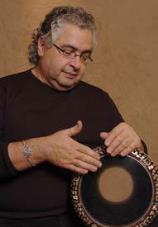About Tablas
Although the Tabla enjoys a great deal of popularity today it did not appear to have been a common instrument in Middle Eastern musical styles until the 19th century. Although drumming has certainly been around much longer the Tabla itself is much newer as an instrument in Middle Eastern music. The goblet drum did exist in ancient Mesopotamia as early as 1100 BCE but is not seen in pictorial evidence again until much later. Whether it went out of fashion and then made a return or was continuously in use since that time and just increased in popularity during the last few centuries is unknown. There is some evidence to suggest that it may have been used in Middle Eastern music prior to the 19th century or at least in a sort of growth or popularization stage between 1200 and 1800. Many of the earliest examples of Tablas in Middle Eastern music come from images of Persian and Turkish musicians. This suggests that it may have been in use in Mesopotamia and Persia continuously throughout the centuries and perhaps started to spread westward through the Islamic world after Persia was conquered by Muslims around the mid 600s. It may also have spread with the waves of Turko-Mongol tribes that continued to sweep through the region. Several images depicting Tablas show them in use by "Gypsies" suggesting the Rom may also have been one element to popularizing the instrument in other areas of the early Islamic world.
The modern Tabla is usually made out of wood, ceramic, clay, aluminum, copper or fiberglass. The heads if natural are generally made from goat skin or fish skin and are attached with string that can be pulled to tighten the head. Synthetic heads are usually mylar (a type of plastic) and are attached by placing them under the rim which is secured by bolts (anywhere from 4-8) which can be tightened to tune the head. While the ceramic and clay drums with natural heads have a slightly more appealing sound they are temperamental and do not adapt well to humidity and temperature change. Their sound also does not carry far as a synthetic mylar head. Aluminum, copper, and fiberglass bodies have the advantage of being lighter and more durable and synthetic heads play consistently well under all temperature and weather changes. Their sound also travels better making them louder and more suitable for use in modern bands as well. Because of this they are favored by professional musicians.
Tablas come in a variety of styles an designs. Many are decorated with carvings, hammered designs, painting, or inlaid designs. Syrian and Egyptian drums often are decorated by inlay using mother-of-pearl, camel bone, and in cheaper versions plastic. Egyptian inlaid designs are generally whiter in appearance while Syrian inlaid designs often have a yellowish or amber tone to them. Turkish drums are often made of aluminum or copper and are decorated with hammered or pressed designs in the metal. Persian drums made from wood often have carved designs and Moroccan drums are often painted in bright colors. Of course you can find Turkish inlaid drums and Hammered Metal designs on Egyptian drums but the above are some generalizations about commonly used regional techniques and designs.
Another noticeable difference is the rim. While most Egyptian Tablas have a curved rim, most Turkish drums have a raised metallic rim. Both are played in approximately the same way despite this difference. Some Goblet drums like the African Djembe or some Persian Tablas do not have the same type of rim. While African drumming does not require the intricate filled patterns of Arabic music which utilize the rim sounds Persian music sometimes does. Persian drummers using this type of drum will sometimes wear metal rings on their fingers which they can strike against the rim to create a filled pattern on this type of drum. 8 bolt drums have a fantastic deep resonance but do not produce the tek and ka sounds of the drum as well as a 6 bolt or 4 bolt drum. This means a professional band will often employ more than one drummer so that both kinds can be used with one drummer focusing on making the deep resonating doums, while the other's main priority is producing crisp clear teks and kas and provide more intricate fill.
If you're looking to buy a Tabla you should make sure you know which type of drum you want based on what's most important to you. If it's mostly for decorative quality you'll probably want to look for an inlaid or hammered metal design. If you're looking to have the best sound quality for playing with a band you'll probably want something want something with a quality mylar head. If you're a period re-enactor or into authenticity at a Renaissance Fair you'll probably be wanting a clay, ceramic, or wood drum with a natural skin head. Of course if you're going to be playing a lot you might want to consider how costly it will be to replace the head. While mylar heads are pretty easy to replace and can be done by pretty much anyone, the skin heads are harder to obtain and are usually better left to a professional to do the actual work.
Here's some examples of different types of Tablas (if the text is too small, right click the image and select "view image"):
If you're looking for how to replace your drum head, tighten it, make minor repairs, etc... be sure to check out the Care of Tablas page. If you're ready to jump right in and learn how to play be sure to visit the Tabla Rhythms and Playing Tips page. Want to hear what the Tabla sounds like? Here's a clip of Hossam Ramzy performing a Tabla Solo.



